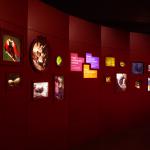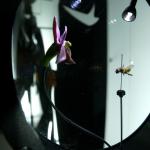EXTRA, the marketplace for scientific touring exhibitions.
Fine weather is back, and so is the time of courtship. A young crested grebe goes off in search of a mate. Sliding across the lake with its reed-filled shallows , keeping his black crest and chestnut ear ruff on display, he sees another grebe swimming farther off. A female, perhaps? He approaches, calmly but not disinterestedly. When they are a few dozen yards apart, they make eye contact and greet each other, flattening their necks at water level. They gradually draw nearer, swell their crests, and emit raucous, resounding cries. They come even closer and display their respective charms in a strange ritual. Remaining face to face, they raise their crests, puff out their colored ruffs and mirror each other’s movements: rapid sideways jerks of their heads and necks, dives, and offerings of blades of grass and other plants They thus offer (each other) a superb aquatic ballet. But at what are they playing?
The two grebes are not playing, but going through their courtship dance. It is the mating season and like all of their fellows of reproductive age they are looking for a mate. The greetings, cries, mirroring, offerings and dances are actually rituals through which they communicate. These rituals enable the males and females to meet, recognize and seduce each other. If they suit each other, they will build a nest together and conceive their offspring.
Peacocks fan their tails, ostriches dance, beluga whales whistle and robins sing. Each species has its own ways and means to speak of love. Do humans, too? Why spend so much time and energy to find a mate? By signaling their presence, don’t these dandies run the risk of being spotted by predators and alerting rivals?
Animals have had to find a balance between being sufficiently obvious to a potential mate and being not too obvious for a predator, while using communication systems that are not too easy to mimic. According to this, the exhibition is divided in four main parts:
PART 1: MATES HAVE TO MEET Aim: to show that many surprising ways of mate attraction exist in nature (diversity of behaviour).
PART 2: SIGNALS HAVE TO BE SENSED Aim: to show that the type of attraction signal used depends upon the environment and the abilities of the animals involved.
PART 3: IMPROPER USE WILL BE REWARDED Aim: to show that some animals are able to imitate attracting signals of other animals in order to attract prey or pollinators, or to confuse rivals. Attackers attracted Aim: to show that some animals are able to perceive attracting signals of other animals in order to find prey or rivals
PART 4: WHAT ABOUT MAN? Aim: to show that humans use many ways of non-verbal communication.




